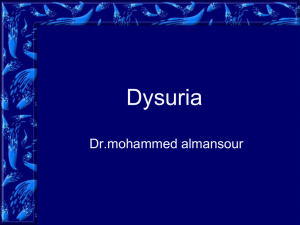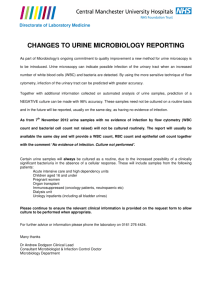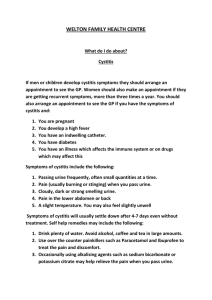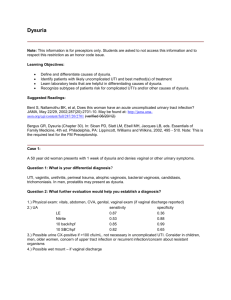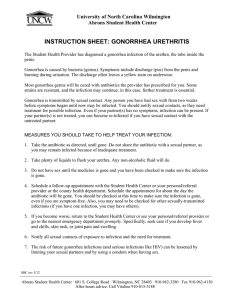Dysuria
advertisement
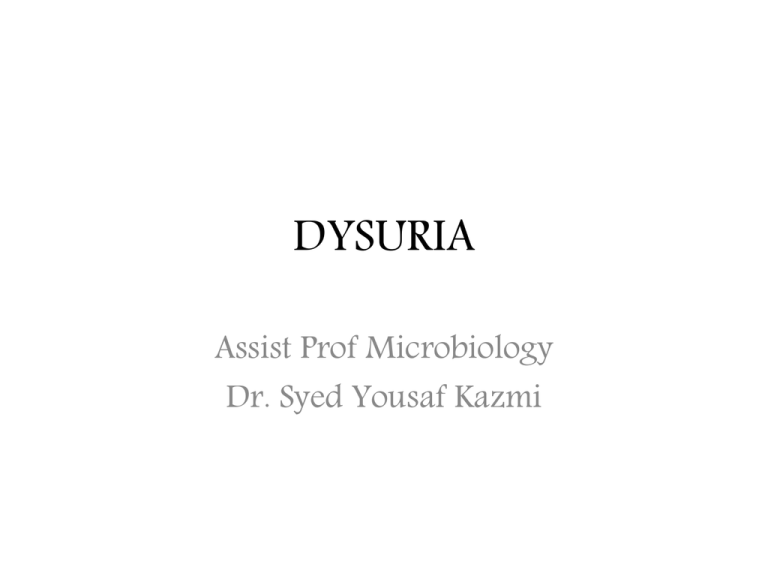
DYSURIA Assist Prof Microbiology Dr. Syed Yousaf Kazmi LEARNING OBJECTIVES 1. Define dysuria 2. Enumerate the major causes of dysuria 3. Discuss common microbiological agents responsible for dysuria 4. Explain the patho- physiological changes 5. Describe the symptoms and signs of presentation 6. Discuss the investigations and principles of management DYSURIA-DEFINITION ‘Painful or difficult urination’ ‘Pain during urination, or difficulty urinating’ ‘Dysuria is the feeling of pain, burning, or discomfort upon urination’ DYSURIA- MAJOR CAUSES A. B. C. D. CAUSES IN MALE CAUSES IN FEMALE CAUSES IN CHILDREN NON GENDER SPECIFIC CAUSES A. CAUSES IN MALE 1. URINARY TRACT INFECTION 2. 3. 4. 5. 6. 7. 8. i. ii. Pyelonephritis (Enterobacteriaceae) Acute Cystitis (Enterobacteriaceae) i. ii. Urethral instrumentation Prior Gonorrhea infection URETHRITIS (Gonorrhea and Chlamydia) PROSTATITIS (Enterobacteriaceae) EPIDIDYMITIS AND ORCHITIS (Enterobacteriaceae, Mumps) MEATITIS and URETHRITIS (HSV II infection) BALANITIS OBSTRUCTIVE UROPATHY (Nodular hyperplasia prostate) URETHRAL STRICTURE 9. MISCELLANEOUS CAUSES Prostatitis 2. CAUSES IN FEMALE 1. URINARY TRACT INFECTION i. ii. Acute Cystitis Pyelonephritis 2. GENITAL HERPES (HSV II) 3. URETHRITIS (Gonorrhea ,Chlamydia ) 4. VULVO-VAGINITIS ( Candida, Trichomonas, Atrophic Vaginitis) 5. URETHRAL SYNDROME (Acute Cystitis symptoms & normal urine) 6. CONTACT DERMATITIS Vaginal Douche, Vaginal lubricant, Spermicidal gel, Contraceptive foams or sponges, Tampons, Perfumed soap, Toilet paper 3. CAUSES IN CHILDREN 1.URINARY TRACT INFECTION 2.CHEMICAL IRRITANTS (e.g. bubble bath) 3.PHYSICAL IRRITANTS i. Self exploration ii. Self-infusion of water into urethra (common in boys) 4.LOCAL INFECTION (e.g. Pinworms) NON GENDER SPECIFIC CAUSES 1. 2. 3. 4. 5. URINARY TRACT INFECTION NEPHROLITHIASIS BLADDER CANCER LOCAL URETHRAL TRAUMA (e.g. Bicycling, catheter) MEDICATION ADVERSE EFFECTS i. Dopamine, Ticarcillin, Penicillin G, Cyclophosphamide i. ii. Saw Palmetto Pumpkin seeds i. ii. Somatization, Chronic Pain Syndrome , Major Depression Sexual abuse 6. FOOD AND HERBAL SUPPLEMENT ADVERSE EFFECTS 7. PSYCHOGENIC CAUSES MICROBIOLOGICAL CAUSES OF DYSURIA URINARY TRACT INFECTION Mainly cystitis Major pathogens usually intestinal flora Most common in women in pregnancy Community acquired: E coli (75%), Klebsiella, Proteus, Staph saphrophyticus, other Enterobacteriaceae Hospital acquired: Enterococcus, Pseudomonas aeruginosa., E coli, Staphylococcus sp., Candida spp Mostly multidrug resistant, catheter related MICROBIOLOGICAL CAUSES OF DYSURIA URETHRITIS 90% symptomatic in male than female Ns. gonorrhea, Chlamydia trachomatis, Ureaplasma urealyticum Trichomonas vaginalis MICROBIOLOGICAL CAUSES OF DYSURIA GENITAL SKIN LESIONS Genital herpes (HSV 2) Chancre ( Syphilis) Candida infection MICROBIOLOGICAL CAUSES OF DYSURIA EPIDIDYMITIS & ORCHITIS Enterobacteriaceae (E. coli, Proteus, Klebsiella etc.) Mumps virus infection Mycobacterium tuberculosis Ns. gonorrhea, Chlamydia trachomatis PATHO-PHYSIOLOGICAL CHANGES Depends upon causative agent Gonorrhea e.g. causes necrosis of urethral epithelium and inflammation Syphilis causes chancre formation and dissemination to other organs HSV infection causes recurrent sores by causing skin blisters and ulcers TB produces granulomatous reaction in tissue infected SIGNS & SYMPTOMS LOWER URINARY TRACT INFECTION (CYSTITIS) Frequent urination An intense urge to urinate Loss of bladder control Pain in the lower front portion of the abdomen Cloudy urine that may have a strong odor, Blood in urine SIGNS & SYMPTOMS UPPER URINARY TRACT INFECTION (PYELONEPHRITIS) Pain in the upper back High fever with shaking chills Nausea and vomiting Cloudy urine Frequent micturition An intense urge to urinate SIGNS & SYMPTOMS URETHRITIS Discharge from the urethra Redness at urethral meatus Frequent urination Vaginal discharge Fever Nausea & vomiting SIGNS & SYMPTOMS VAGINITIS Pain, soreness or itching in the vagina An abnormal or foulsmelling vaginal discharge or odor Pain or discomfort during sexual intercourse INVESTIGATIONS URINE ROUTINE EXAMINATION Color: May be normal, or reddish color (hematuria) Smell: Normal to offensive in certain infections Turbidity: In UTI, usually turbid urine Protein: usually present in UTIs RBCs: May be present in UTIs, other infections, WBCs: Usually >10-20/HPF URINE ROUTINE EXAMINATION MICROSCOPY WBCs, RBCs, in UTIs Can visualize bacteria, yeast cells in UTIs and other infections Trichomonas vaginalis motility RBCs WBCs Trichomonas vaginalis in urine CULTURE OF SPECIMENS A. URINE CULTURE Easy way of diagnosing UTI Antimicrobial sensitivity helpful in treatment Helpful in cystitis and pyelonephritis Negative cultures do not rule out UTIs(Fastidious org, etc.) B. DISCHARGE FOR C/S Urethral discharge, vaginal discharge Helpful in diagnosing gonorrhea, and vaginitis LAB INVESTIGATION OF STIs A. DARK FIELD MICROSCOPY For motility of Spirochetes e.g. Treponema pallidum B. IMMUNOFLOURESENSCE TEST For Chlamydia trachomatis from urethral discharge C. SEROLOGICAL TESTS FOR SYPHILIS RPR test, FTA Adsorbed test, TP PA test etc. MANAGEMENT PROTOCOLS Each disease merits its specific treatment UTI must be diagnosed by C/S and given antimicrobial course Empiric therapy may be instituted in severe conditions and amended on report of C/S Local antimicrobial susceptibility pattern must be known to the physicians Syphilis, Gonorrhea, Chlamydia etc. needs protocols like, Penicillin G, Ceftriaxone, oral doxycyclin respectively For Candida vaginitis, local & systemic antifungal treatment reqd

